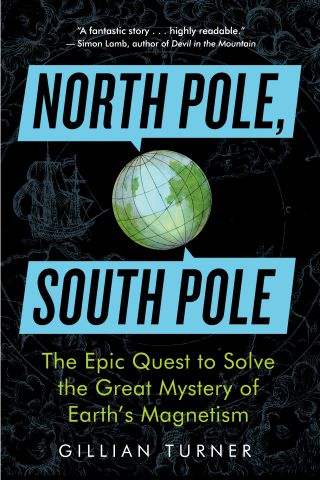![]() Strange as it might seem, I’m finding North Pole, South Pole, paleomagnetist Gillian Turner’s newly published account of “the epic quest to solve the great mystery of Earth’s magnetism”, a difficult book to review. It’s not that I didn’t enjoy reading it; I did. I found it both interesting and well written (Gillian has a talent for making scientific papers almost enjoyable to read, so I hardly expected otherwise). The problem is that I’m not your average reader: I’ve spent a large chunk of my geological career so far studying ancient rock magnetisations, so it’s hardly a surprise that I’d be interested in the scientific history of my field.
Strange as it might seem, I’m finding North Pole, South Pole, paleomagnetist Gillian Turner’s newly published account of “the epic quest to solve the great mystery of Earth’s magnetism”, a difficult book to review. It’s not that I didn’t enjoy reading it; I did. I found it both interesting and well written (Gillian has a talent for making scientific papers almost enjoyable to read, so I hardly expected otherwise). The problem is that I’m not your average reader: I’ve spent a large chunk of my geological career so far studying ancient rock magnetisations, so it’s hardly a surprise that I’d be interested in the scientific history of my field.

North Pole, South Pole, by Gillian Turner
Even so, I believe that the story than Gillian tells is not just of interest to me and my paleomagnetic brethren, because it turns out that even before scientists were calling themselves scientists, they were asking: why does a compass needle point north? The ancient Greeks knew of the magnetic properties of lodestone, and compasses have been around for almost two millennia. These devices were utterly useful for navigation, and hence a vital cog in trade and the maintenance of empires (compasses are still used to guide our ships and our airliners, and it is only in the past decade or two, with the advent of GPS, that you could potentially navigate safely without one). And yet, at the same time, they were utterly mysterious: a fact that must have been of some concern to those engaged in trade and empire building: it’s never a good idea to be totally reliant on something you neither control, nor even understand.
Early scientists tended to be somewhat promiscuous in their interests, but the mystery of magnetism was certainly something that cropped up with some regularity as the modern scientific enterprise grew and took shape over the last millennium. The first known work of experimental science in Europe? An exploration of the magnetic properties of lodestone, written by Petrus Peregrinus in 1269, that also presciently argued that the Earth was magnetised in the same way that a compass needle was. The first known research cruise? A voyage to measure variations in magnetic declination – the difference between true north (as determined from the stars) and magnetic north organised by Edmond Halley in 1698. One of the earliest international scientific collaborations? A network of geomagnetic observatories, set up in the early 19th century by Carl Gauss, Alexander von Humboldt and Edward Sabine, to collect enough measurements to accurately model the Earth’s magnetic field. Explorations of the connections between magnetism and electricity by the likes of Ørsted, Ampère, Faraday and Maxwell led to dynamos, radio and the modern world as we know it, as well as offering the first glimpses into how the Earth’s magnetic field was actually generated. Paleomagnetism itself, born from attempts to understand the wandering of magnetic north around the Arctic Ocean, was a key part of the discovery of plate tectonics, both by confirming the slow drift of continents over geological time, and providing the killer bit of evidence for seafloor spreading in the form of the seafloor stripes formed by magnetic field reversals.
All of this and more is explained with great clarity in Gillian’s book, all framed in terms of the slow progress towards the understanding that the Earth is a big magnet, and the even longer quest to explain why. The story continues right up until the present day: it is still less than 20 years since a decent model of a geodynamo produced by convection in the outer core was finally produced. At the heart of the book is a coherent narrative that manages to lucidly cover a large amount of territory in the history of science, and the science of magnetism. It’s not a narrative driven by a single personality, in the vein of Longitude or The Map That Changed the World, which may put some people off, but if you’re interested in finding out how we know what we know about the Earth’s magnetic field, or would like a gentle introduction to the forces that orient your compass needle, North Pole, South Pole is well worth reading.
North Pole, South Pole is published by The Experiment Publishing and is available on Amazon (USA, UK)



Links (2)-
-
Pingback: Portolan Maps: the medieval GPS? | Highly Allochthonous
Pingback: The Giant’s Shoulders #36: The ABCs of the History of Science « The Dispersal of Darwin